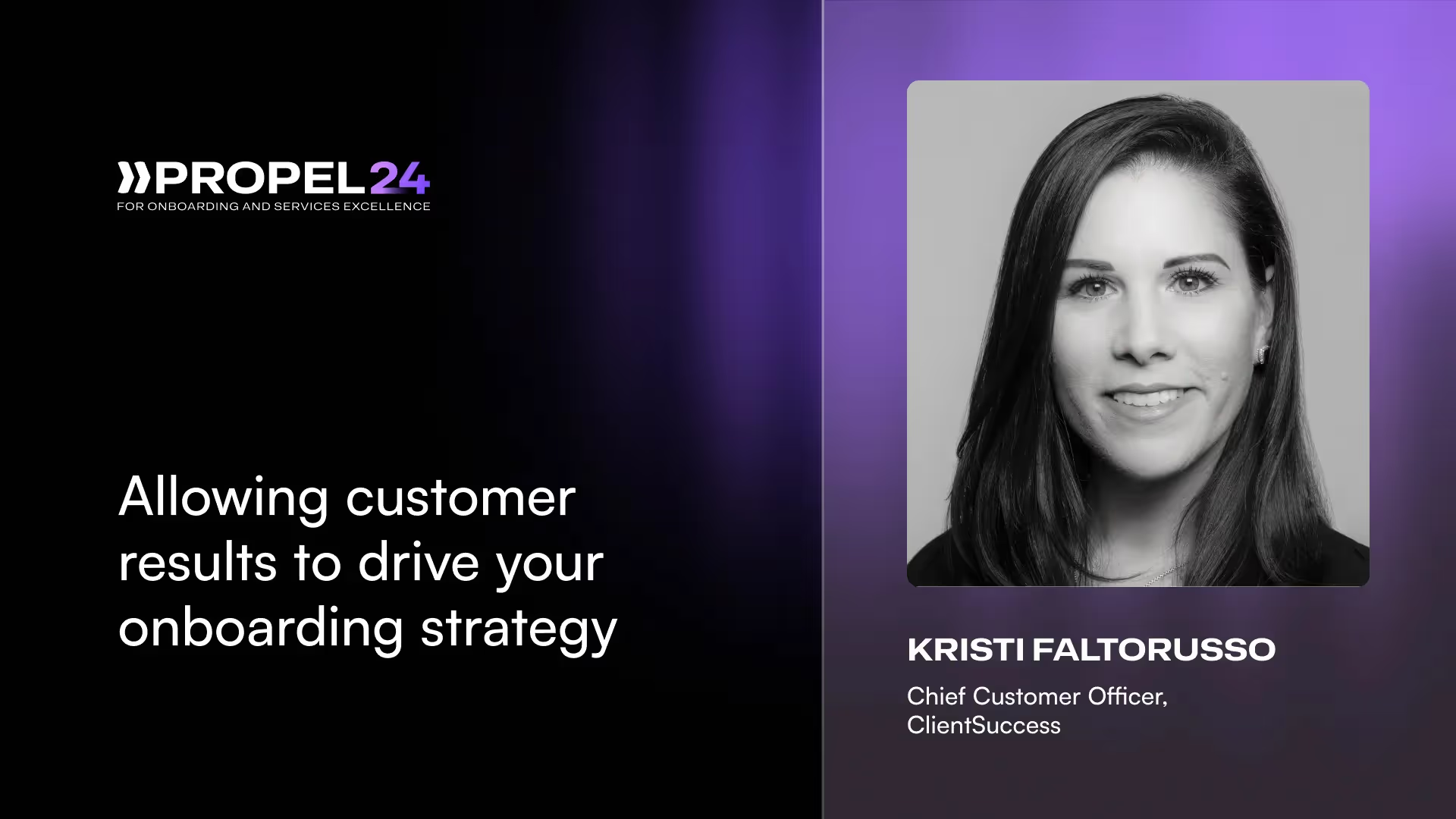Research shows that 74% of clients will explore other solutions if the onboarding process is too complicated.
Complexity is the enemy of understanding. Consider how much time you spend trying to simplify things. How often have we requested ChatGPT to "explain like I'm five"?
Moreover, defining and measuring complexity is often subjective. Complexity can also arise when things aren't relatable. For successful onboarding and implementation, it's important that the customer feels connected and engaged.
Many organizations, in their efforts to drive efficiency and expedite time to value, have over-engineered their customer onboarding processes. While these processes may streamline internal workflows, they often fail to ensure that customers achieve the results they expect during the early stages of onboarding and implementation.
This statistic highlights the importance of simplicity in onboarding. However, simplicity alone is not enough; the process must also enable customers to see real, tangible results early on.
At Propel24, the world's first customer onboarding professional services conference, Kristi Faltruso presented a session on centralizing customer results during the onboarding process. She focused on ensuring that the onboarding phase aligns with customer goals to deliver tangible results. In this session, she discussed common pitfalls in onboarding strategies and introduced a structured approach developed at ClientSuccess to overcome these challenges.
Common pitfalls in customer onboarding
Here are some common mistakes that most organizations make during customer onboarding:
One-size-fits-all approach
Most organizations still employ a one-size-fits-all customer onboarding program. This linear process doesn't account for the unique needs and goals of different customers. While there may be some variations based on the complexity of the solution, the approach remains largely uniform.
Internal focus over customer needs
Another issue is the internal focus on timelines to determine time to value. This often leads to a checklist mentality, where organizations ensure they have covered all bases but fail to tailor the setup to what customers need in the early stages.
Lack of defined onboarding success metrics
A significant challenge is the difficulty in defining and understanding customer goals upfront. Many Customer Success Managers (CSMs) cannot articulate how their customers define success. This lack of clarity can result in an onboarding process that fails to meet customer expectations.
Objectives-first customer onboarding approach
Kristi discusses ClientSuccess's "objectives-first" customer onboarding approach to address these challenges. This model focuses on aligning the onboarding process with the specific KPIs of our customers.
Step 1: Defining business objectives
The first step in our process is for customers to define their business objectives clearly. Kristi created a framework with seven clear objectives for purchasing a customer success solution:
- Democratize data
- Increase visibility
- Operationalize processes
- Mitigate risk
- Identify growth
- Drive efficiency
- Scale with ease
These objectives help us tailor the onboarding process to meet the specific needs of our customers.
Step 2: Designing a product plan
Once we understand their core objective, it initiates a comprehensive customer onboarding workflow tailored to it.
For instance, If a customer's objective is to mitigate risk, the onboarding design would involve importing customer data into a CRM, segmenting customers, and developing 'Pulse Plans' for health scoring (Pulse is a product in ClientSuccess that assigns a health score to customers on a scale of one to six).
The team helps clients identify common risks and success factors, then assigns a health score that measures key activities and indicates if a customer is behaving well, configuring success cycles around risk indicators, setting up automations, training end-users, and benchmarking progress. This approach ensures that the product is configured meaningfully to address the specific risk-related goal from the outset.
Now, there are seven such core business objectives, each with a specific plan to help customers configure the product to meet their goals in a few steps and sessions. This approach became crucial as our product has many features, and traditional onboarding covered all of them, which could overwhelm new users. While advanced customers might manage comprehensive onboarding, most benefit from this targeted method. It allows them to stay focused on their primary objectives, ensuring the product configuration aligns with their specific goals, such as mitigating risk.
Step 3: Tracking toward the goal
Focus on consistently engaging with our customers to align with their objectives. The goal is to clearly understand what our customers aim to achieve, which, in this case, is mitigating risk. We assist our customers in setting SMART goals—specific, measurable, achievable, relevant, and time-bound.
Example goal
Customers will articulate a goal, such as reducing at-risk customers in their strategic segment by 10% by the end of Q3. This goal is specific, has clear timelines, and targets a defined customer segment.
We encourage customers to refine their goals further. For example, they might aim to identify and deploy a saved plan for strategic segment customers renewing in Q4 with a success score below 50. This provides even more specificity and clarity.
- Segmentation: We help customers identify which strategic accounts are renewing in Q4 and have a success score below 50, using data from their CRM and our success scoring system.
- Configuration: We ensure the product is configured to support the specified goals, providing the necessary tools and setups.
- Tracking Progress: Each Customer Success Manager (CSM) tracks progress toward the goal, using our product to identify and address risk factors for each customer.
Success cycles
Tailored success cycles address various risk factors affecting customer engagement. These cycles, akin to playbooks, guide Customer Success Managers (CSMs) in targeting specific issues like low product adoption, engagement, or outstanding payments.
CSMs track progress towards predefined goals, such as increasing adoption or engagement, by monitoring key metrics and striving to elevate customer scores. This approach ensures focused efforts to drive positive outcomes for clients.
Measuring success
Progress is tracked to see if customers' success scores improve, even if not all customers reach the target score immediately. The aim is to demonstrate value and movement in the right direction.
Celebrating success
As customers see progress, we celebrate these milestones. The ultimate goal is for customers to perceive value in our product configuration and to see tangible improvements. While customer success is a lagging indicator, the initial signs of progress are crucial for demonstrating the solution's effectiveness and potential.
By aligning our efforts with customer goals, we help them realize the value of our product and ensure they are on the right track toward achieving their objectives.
Benefits of the new customer onboarding model
These are the benefits we're experiencing from implementing this deployed program:
1. Higher impact
Customers can see the solution's value and how it helps them achieve measurable wins. This approach contrasts with traditional checklist-based customer onboarding, often failing to deliver meaningful impact. Ultimately, what's effective is the ability to have strategic customer conversations, especially with executive stakeholders, where we can demonstrate the value and impact of our partnership.
2. Higher customer engagement
By focusing on one objective during onboarding while still acknowledging the existence of six other objectives, we allow customers to prioritize their needs effectively. By stacking and ranking these objectives, we establish a clear roadmap for success. With progress on the initial objective, we seamlessly transition to addressing the next priority. For instance, if the first focus was risk mitigation, the next could be operationalizing processes. This approach creates a series of ongoing "micro onboarding" sessions that drive continuous customer engagement. With a structured roadmap in place, conversations with customers are no longer about what to cover but rather about tracking progress and impact.
3. Pathway to growth
Focusing on early impact and continuous engagement fosters a clear pathway for customer growth. As customers see value, they are more likely to expand their product use, invite more users, and explore additional modules.
For instance, if a customer focuses on increasing visibility or identifying growth opportunities, they might choose to add different parts of our product to achieve these outcomes. Essentially, we've shifted our approach from driving the onboarding process based on our assumptions to letting customers lead by expressing their priorities and needs. This framework allows them to see the direct correlation between their objectives and the impact of our solution, leading to success.
Customers who see value in our solution are more likely to stay and grow, which is the focus of our redeployed process.
{{demo}}






















.webp)